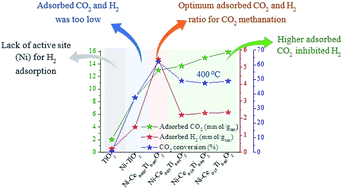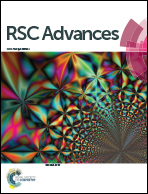The role of Ce addition in catalytic activity enhancement of TiO2-supported Ni for CO2 methanation reaction†
Abstract
In this work, various amounts of Ce were added to TiO2 to form a mixed oxide support; CexTi1−xO2 (x = 0, 0.003, 0.05, 0.10 and 0.15) and then those synthesized supports were impregnated by 10 wt% Ni to produce a catalysts. The 10 wt% Ni–CexTi1−xO2 (x = 0, 0.003, 0.05, 0.10 and 0.15) catalysts were tested for CO2 methanation reaction by using a fixed-bed reactor in the temperature range of 100–500 °C. The sample was pretreated at 450 °C under H2 and then a mixed feed gas of CO2 and H2 was switched into the reactor to start the reaction. The results showed that 10 wt% Ni–Ce0.003Ti0.997O2 catalyst (the lowest Ce content) exhibited the highest CO2 conversion and CH4 yield. Moreover, 10 wt% Ni–Ce0.003Ti0.997O2 showed highly stable during the stability test (50 h.). The results indicated that upon addition of small amount of Ce into TiO2-supported Ni, the surface, structural, electrical and redox properties of the catalyst were improved to the extent that these properties can promote the catalytic activities for CO2 methanation. The Ce addition can improve the CO2 methanation catalytic activity by several ways. First, higher dispersion of Ni on catalysts surface upon addition of Ce was observed which resulted in higher adsorption rate of H2 on this metal active site. Second, formation of a larger amounts of oxygen vacancies as well as basicity improvement upon addition of Ce were occurred which can increase the CO2 adsorption on catalyst surface. Third, incorporation of Ce resulted in improving of a starting reduction temperature of Ni2+ to Ni0 for TiO2-supported Ni catalyst which can indicate that the reducibility of Ce-doped TiO2-supported Ni catalyst was enhanced and then alter its catalytic activity. However, increasing of Ce content led to lowering of CO2 methanation activities which resulted from increasing of basicity by Ce addition. The excess amounts of adsorbed CO2 would lead to competitive adsorption to H2 and then lead to a decrease of catalytic activity. Therefore, an appropriate amount of H2 and CO2 adsorption ability on catalyst surface was a prominent factor to dominate the catalytic activity.



 Please wait while we load your content...
Please wait while we load your content...